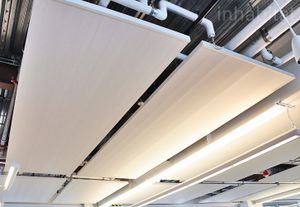Cooling Panels
Cooling Panels are generally attached to ceilings, but can be attached to walls. They are usually suspended from the ceiling, but can also be directly integrated with continuous dropped ceilings. Modular construction offers increased flexibility in terms of placement and integration with lighting or other electrical systems. Lower thermal mass compared to chilled slabs means they can’t easily take advantage of passive cooling from thermal storage, but controls in panels can more quickly adjust to changes in outdoor temperature. Chilled panels are also better suited to buildings with spaces that have a greater variance in cooling loads.Perforated panels also offer better acoustical dampening than chilled slabs. Ceiling panels are also very suitable for retrofits as they can be attached to any ceiling. Chilled ceiling panels can be more easily integrated with ventilation supplied from the ceiling. Panels tend to cost more per unit of surface area than chilled slabs.
Cooling panels, although relatively rare in North America, have been used successfully in European applications for at least 15 years. Cooling panels follows the same principles as radiant heating, but in reverse. Thermal energy is exchanged between the heat loads present in the space, and the cool ceiling.
To ensure air quality and removal of the moisture load in the room, cooling panels need to be used in conjunction with a small ventilation system. However, since cooling systems do not use forced air flow to facilitate cooling, a uniform cooling gradient in the room is created. With this reduction in draft,cooling panels provide a very comfortable environment for the occupants of the cooled space.
Cooling panels are mainly used in public buildings. These include: hospitals, office buildings, libraries, museums, schools, nursing homes and many more.Cooling panels can be installed anywhere radiant heating panels are used.

